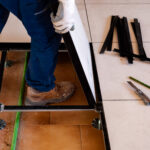Porcelain stoneware is a high-performance, sustainable solution for today’s construction sector. Used in low environmental impact raised floors and eco-sustainable façade cladding, it guarantees strength, durability and aesthetic versatility. Understanding porcelain stoneware’s building life cycle is essential for professionals who want to use eco-sustainable architectural materials in their advanced green building projects.
From production to the building site. Porcelain stoneware as a low environmental impact material
The low-energy production cycle of porcelain stoneware is designed to minimize environmental impact and optimize the material’s technical performance. There are 4 steps in the porcelain stoneware production process:
- Preparing the raw materials, including selecting and grinding clays, feldspars and silica sands.
- Pressing and shaping, using high energy-efficiency presses.
- Firing in heat-recovery kilns that help reduce CO2 emissions in porcelain stoneware production.
- Finishing and quality controls that leverage processes with low water consumption and no harmful substances.
This production sequence preserves the technical features of porcelain stoneware. So it can be used in building solutions that are durable and have a low environmental impact.
The benefits of porcelain stoneware in green building projects
One of the main properties that make porcelain stoneware an ideal cladding material for green building projects are its key features that combine high performance, durability and low environmental impact:
- Porcelain stoneware scratch resistance. The material guarantees high surface hardness and the ability to withstand intense mechanical stress. This feature reduces the need for frequent replacements, thereby reducing resource consumption and the environmental impacts related to production and scrap disposal.
- Porcelain stoneware retains dimensional stability in environments subject to temperature fluctuations. Its minimal thermal expansion and contraction is ideal for applications in raised porcelain stoneware floors or surfaces exposed to climate variations.
- Porcelain stoneware cladding requires minimal maintenance. Its surfaces are easy to clean and resistant to stains, chemicals and wear from daily use. Reduced maintenance means less use of chemical detergents and lower water and energy consumption.
In addition to ensuring durability and mechanical resistance, using porcelain stoneware in buildings that are NZEB – Nearly Zero Energy Buildings – helps improve their energy efficiency by sustaining and promoting design solutions geared to the use of eco-sustainable architectural materials.

Porcelain stoneware features for façade claddings and technical eco-sustainable floors
As an eco-sustainable material for façades, porcelain stoneware stands out for its high level of physical and mechanical properties that are ideal for both eco-sustainable façade cladding and porcelain stoneware raised floors with a low environmental impact. Key porcelain stoneware features for ventilated façades and technical flooring include:
- Weather resistance. Porcelain stoneware is water, frost, acid rain and UV ray resistant.
- Thermal and dimensional stability. Porcelain stoneware is expansion, contraction, deformation, detachment and crack resistant even in the event of major temperature variations.
- Aesthetic versatility. Thanks to a wide range of colours and finishes, porcelain stoneware can be customised without affecting performance.
- Easy to inspect and replace. Modular and accessible porcelain stoneware panels simplify maintenance and targeted interventions, without affecting the integrity of the surface and underlying systems.
These qualities make the use of porcelain stoneware in eco-sustainable cladding the ideal choice for projects that require high-performance building materials with a low environmental impact.
The best eco-sustainable building materials. Why choose porcelain stoneware?
Porcelain stoneware stands out amongst the best eco-sustainable building claddings as it is one of the most durable and reliable solutions with a low environmental impact. Its high mechanical performance, combined with long-term dimensional stability, guarantees extended life cycles and reduced maintenance requirements that boost the sustainability of green building projects significantly. At the end of its life, porcelain stoneware can be disposed of or recycled in ways that allow it to be turned into a precious resource. Thanks to grinding processes, it can be recovered and reused as an inert material or as a component for substrates and screeds, which means it is part of a virtuous circular economy model.
This life cycle and these characteristics make porcelain stoneware ideal for high-performance applications, like low environmental impact ventilated façades and raised floors that combine technical efficiency and environmental friendliness.To discover how to best include porcelain stoneware in your projects, contact Imola Tecnica. Our team of experts will help you select and implement cladding systems with a high technical and environmental value.



